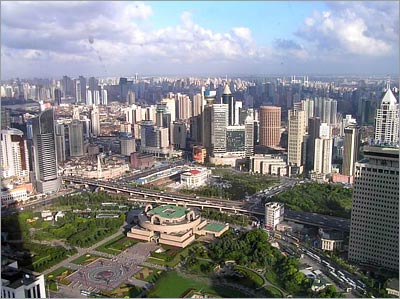China had 661 cities by the end of 2004, of which 11 had
populations of more than four million in the urban area; 22 had
between two and four million; 141 had between one and two million;
274 had between 500,000 and one million; 173 had between 200,000
and 500,000; and 40 had fewer than 200,000.?
In the course of city planning, China implements the principle
of "strictly control over the size of large cities, rational
development of medium-sized cities and active development of small
cities." Medium-sized cities with populations of between 200,000
and 500,000 and small cities with populations fewer than 200,000
have grown rapidly since the 1980s and the large cities with
populations of over one million have developed satellite cities and
towns in a planned and positive way.?
Beijing?
Beijing is a municipality directly under the Central Government
and the capital of China. It is not only the nation's political
center, but also its cultural, scientific and educational center,
and a key transportation hub. Situated on the northern edge of the
North China Plain, it is sheltered by chains of mountains to the
west, north and east. Its southeastern part is a plain. Beijing's
temperate continental climate produces four clearly contrasted
seasons: a short spring, rainy and humid summer, long and cold
winter, and a very pleasant autumn.?
Beijing emerged as a city as far back as the Western Zhou
Dynasty (1046-771 BC), when it was known as Ji. During the Warring
States Period (475-221 BC), it was the capital of the State of Yan.
Ji remained a city of strategic importance and a trade center for
the north for well over a thousand years. Then, in the early 10th
century, under the name of Yanjing, it became the secondary capital
of the Liao Dynasty. Between 1115 and 1911, it served as the
capital of the Jin, Yuan, Ming and Qing dynasties in succession,
thus becoming a storehouse of Chinese culture, and leaving many
historical legacies. Among these, the Imperial Palace, the Great
Wall, the site of Peking Man at Zhoukoudian, the Summer Palace, the
Temple of Heaven and the Ming Tombs have been put on the UNESCO
World Cultural Heritage list.
Since it became the nation's capital in 1949, especially since
the 1980s, the rapid urban development of Beijing has brought
tremendous changes to the city's appearance. Beijing of today, with
its many broad roads and tall buildings, while preserving the
features of the ancient capital, is truly a modern international
city.
Shanghai
 |
Shanghai, a municipality directly under the Central Government,
is China's largest city. Advantageously located, Shanghai is
halfway down China's mainland coastline, where the Yangtze River
empties into the sea. As an important comprehensive industrial base
and port, Shanghai plays an essential role in the national economy.
Major industries include metallurgy, machine-building,
shipbuilding, chemicals, electronics, meters, textiles and other
light industries, in addition to its highly developed commerce,
banking and ocean shipping industry. The Pudong New Zone, separated
from the old city by the Huangpu River, has been undergoing
vigorous development and construction since 1990s. The opening and
development of the Pudong New Zone is intended to put it on a par
with the world's best within several decades, as a modern,
multi-functional, export-oriented district, thus laying the
foundation for the transformation of Shanghai into an international
economic, banking and trade center, and a modern international
metropolis.
Tianjin
Another municipality directly under the Central Government,
Tianjin is a major industrial and commercial city in north China.
About 120 km from Beijing, Tianjin is an important port for ocean
and offshore shipping, and foreign trade. Tianjin's traditional
industries include iron and steel, machine-building, chemicals,
electric power, textiles, construction materials, paper-making and
foodstuffs, plus some emergent industries such as shipbuilding,
automobile manufacturing, petroleum exploitation and processing,
and the production of tractors, chemical fertilizers, pesticides,
watches, TVs and cameras.
Chongqing
Also a municipality directly under the Central Government,
Chongqing is the largest industrial and commercial center in
southwest China, and a hub of land and water transportation in the
upper Yangtze valley. Chongqing is a comprehensive industrial city,
with advanced iron and steel, chemicals, electric power, automobile
manufacturing, machine-building, shipbuilding, construction
materials, textiles, foodstuffs and pharmaceutical industries.